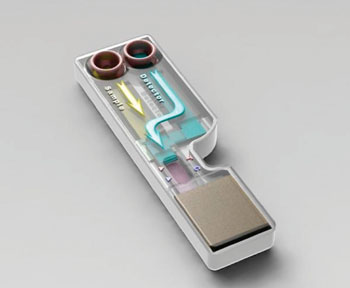Rapid Test Kit Detects Dengue Antibodies in Saliva
By LabMedica International staff writers
Posted on 10 Feb 2015
A paper-based disposable device has been developed that will allow dengue-specific antibodies to be detected easily from saliva within 20 minutes and the device is currently undergoing further development.Posted on 10 Feb 2015
Paper-based immunoassays, usually in the form of lateral flow tests, are currently the standard platform for home diagnostics. However, conventional lateral tests are often complicated by severe nonspecific adsorption of detector particles when applied to test samples containing salivary fluid.

Image: A three dimensional model of the rapid test kit that detects dengue-specific antibodies (Photo courtesy of the Agency for Science, Technology and Research, A*STAR).
Scientists at the Institute of Bioengineering and Nanotechnology (The Nanos; Singapore) developed a stacking flow device consisting of a test strip, a sample pad, a reagent pad, an absorbent pad, and a flow regulator. The sample and reagent pads were made of glass fiber, and the absorbent pad was made of cellulose (Merck Millipore, Billerica, Massachusetts, USA). The nitrocellulose test strip was cut into the required dimensions manually with a roller cutter. The detection of dengue-specific immunoglobulin G (IgG) was conducted using the liquid conjugate approach. The liquid conjugate was composed of protein G-conjugated 40 nm gold nanoparticles.
In the device, different flow paths are created for samples and reagents through a multiple stacked system. This allows the saliva sample to flow separately through a fiber glass matrix, which removes the substances that would interfere with the nanoparticle-based sensing system before it mixes with the sensor nanoparticles. The device’s configuration also helps to regulate the flow in the test strip, generating uniform test lines for more accurate results. The stacking flow immunoassay platform requires only one user activation step: both the sample and reagents are added at the same time in a single step. Both the sample and reagents react and flow concurrently in the test strip. The single-step procedure significantly improved the ease of usage of the test kit. The study was published on January 12, 2015, in the journal Lab on a Chip.
Related Links:
Institute of Bioengineering and Nanotechnology
Merck Millipore













